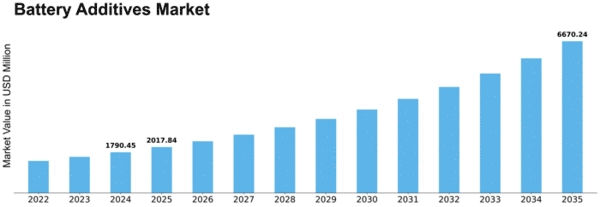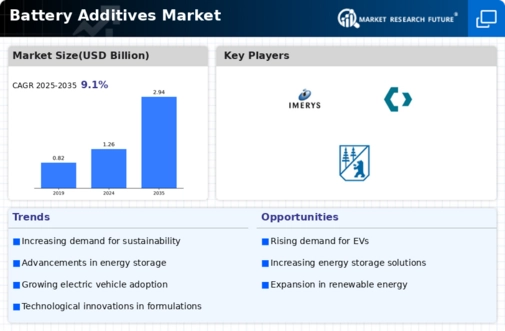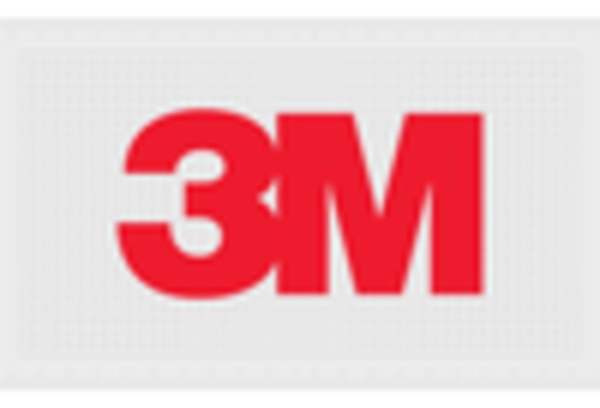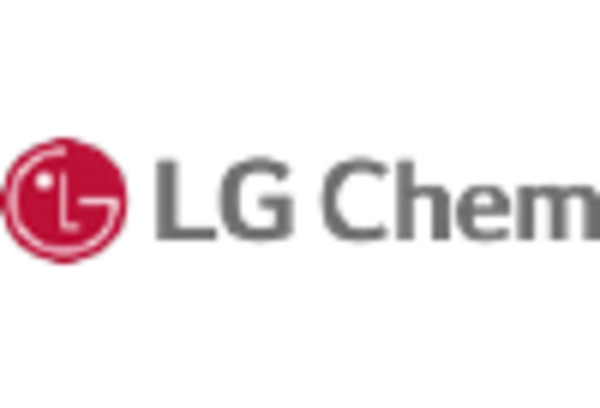-
Executive Summary
-
Market Introduction
-
Market Definition
-
Scope of the Study
-
List of Assumptions
-
Markets Structure
-
Market Research Methodology
-
Research Process
-
Primary Research
-
Secondary Research
-
Market Size Estimation
-
Forecast Model
-
Market Dynamics of Global Battery Additives Market
-
Introduction
-
Drivers
-
Restraints
-
Opportunities
-
Challenges
-
Trends/Technology
-
Market Factor Analysis of Global
-
Battery Additives Market
-
Supply Chain Analysis
- Raw Material
- Manufacturers/Producers
- Distributors/Retailers/Wholesalers/E-Commerce
- End Users
-
Suppliers
-
Porter’s Five Forces Analysis
- Threat
- Bargaining Power of Buyers
- Bargaining Power
- Threat of Substitutes
- Intensity of Competitive
-
of New Entrants
-
of Suppliers
-
Rivalry
-
Global Battery Additives Market, by Type
-
Introduction
-
Conductive Additive
- Market Estimates & Forecast, 2021-2030
- Market Estimates & Forecast, by Region, 2021-2030
-
Porous Additive
- Market Estimates & Forecast, 2021-2030
- Market Estimates &
-
Forecast, by Region, 2021-2030
-
Nucleating Additive
- Market Estimates
- Market Estimates & Forecast, by Region,
-
& Forecast, 2021-2030
-
Global Battery Additives Market, by Application
-
Introduction
-
Li-Ion Batteries
- Market Estimates & Forecast, 2021-2030
- Market Estimates & Forecast, by Region, 2021-2030
-
Application
-
Market Estimates & Forecast, by Region, 2021-2030
-
& Forecast, by Region, 2021-2030
-
& Forecast, 2021-2030
-
Batteries
-
Estimates & Forecast, by Region, 2021-2030
-
Portable Devices
-
Market Estimates & Forecast, 2021-2030
-
Market Estimates
-
EVs
-
Market Estimates
-
Market Estimates & Forecast, by Region,
-
Others
-
Market Estimates & Forecast, 2021-2030
-
Market Estimates & Forecast, by Region, 2021-2030
-
Lead-Acid
- Market Estimates & Forecast, 2021-2030
- Market
-
Global Battery Additives
-
Market, by Region
-
Introduction
-
North America
- Market
- Market Estimates & Forecast,
- Market Estimates & Forecast, by Application, 2021-2030
- US
-
Estimates & Forecast, 2021-2030
-
by Type, 2021-2030
-
Market Estimates & Forecast, by Type, 2021-2030
-
& Forecast, by Application, 2021-2030
-
Estimates & Forecast, 2021-2030
-
by Type, 2021-2030
-
& Forecast, by Application, 2021-2030
-
Estimates & Forecast, 2021-2030
-
by Type, 2021-2030
-
Estimates & Forecast, by Application, 2021-2030
-
Market Estimates & Forecast, 2021-2030
-
by Type, 2021-2030
-
Estimates & Forecast, by Application, 2021-2030
-
Estimates & Forecast, 2021-2030
-
by Type, 2021-2030
-
Estimates & Forecast, by Application, 2021-2030
-
Market Estimates & Forecast, 2021-2030
-
Forecast, by Type, 2021-2030
-
Market Estimates
-
Canada
-
Market
-
Market Estimates & Forecast,
-
Market Estimates & Forecast, by Application,
-
Europe
- Market Estimates & Forecast, 2021-2030
- Market Estimates & Forecast, by Type, 2021-2030
- Market Estimates
- Germany
- France
- Italy
- Spain
- UK
- Russia
- Poland
- Rest of Europe
-
Market Estimates & Forecast, by Application, 2021-2030
-
Asia-Pacific
- Market Estimates & Forecast, 2021-2030
- Market Estimates &
- Market Estimates & Forecast, by Application,
- China
- India
- Japan
- Australia & New
- Rest of Asia Pacific
-
Forecast, by Type, 2021-2030
-
Estimates & Forecast, by Application, 2021-2030
-
Market Estimates & Forecast, 2021-2030
-
by Type, 2021-2030
-
Estimates & Forecast, by Application, 2021-2030
-
Zealand
-
Estimates & Forecast, by Type, 2021-2030
-
Forecast, by Application, 2021-2030
-
Market Estimates & Forecast, 2021-2030
-
by Type, 2021-2030
-
Middle East & Africa
- Market Estimates & Forecast,
- Market Estimates & Forecast, by Type, 2021-2030
-
Market Estimates & Forecast, by Application, 2021-2030
-
Market Estimates & Forecast, 2021-2030
-
by Type, 2021-2030
-
Estimates & Forecast, by Application, 2021-2030
-
Market Estimates & Forecast, 2021-2030
-
by Type, 2021-2030
-
Estimates & Forecast, by Application, 2021-2030
-
& Africa
-
GCC
-
Market Estimates & Forecast,
-
Market Estimates & Forecast, by Application,
-
Israel
-
Market Estimates & Forecast, 2021-2030
-
Market Estimates & Forecast, by Type, 2021-2030
-
Market
-
North Africa
-
Market Estimates & Forecast,
-
Market Estimates & Forecast, by Application,
-
Turkey
-
Market Estimates & Forecast, 2021-2030
-
Market Estimates & Forecast, by Type, 2021-2030
-
Market
-
Rest of Middle East
-
Market Estimates & Forecast, 2021-2030
-
Market Estimates & Forecast, by Type, 2021-2030
-
& Forecast, by Application, 2021-2030
-
Estimates & Forecast, 2021-2030
-
by Type, 2021-2030
-
Market Estimates
-
Latin America
- Market
- Market Estimates & Forecast,
- Market Estimates & Forecast, by Application, 2021-2030
- Brazil
-
Market Estimates & Forecast, by Type, 2021-2030
-
& Forecast, by Application, 2021-2030
-
Estimates & Forecast, 2021-2030
-
by Type, 2021-2030
-
Estimates & Forecast, by Application, 2021-2030
-
& Forecast, by Type, 2021-2030
-
by Application, 2021-2030
-
Market Estimates
-
Mexico
-
Market
-
Market Estimates & Forecast,
-
Market Estimates & Forecast, by Application,
-
Argentina
-
Market Estimates & Forecast, 2021-2030
-
Market Estimates & Forecast, by Type, 2021-2030
-
Market
-
Rest of Latin America
-
Market Estimates & Forecast, 2021-2030
-
Market Estimates
-
Market Estimates & Forecast,
-
Company Landscape
-
Introduction
-
Market Strategy
-
Key Development Analysis (Expansion/Merger & Acquisition/Joint
-
Venture/New Product Development/Agreement/Investment)
-
Company Profiles
-
Cabot Corporation
- Company Overview
- Financial Updates
- Product/Business Segment Overview
- Strategy
- Key
- SWOT Analysis
-
Developments
-
3M
- Company Overview
- Financial Updates
- Product/Business Segment Overview
- Key Developments
- SWOT Analysis
-
Strategy
-
Imerys
- Company Overview
- Financial Updates
- Product/Business
- Strategy
- Key Developments
- SWOT
-
Segment Overview
-
Analysis
-
Hammond
- Company Overview
- Financial Updates
- Product/Business Segment Overview
- Strategy
- Key
- SWOT Analysis
-
Developments
-
SGL Carbon
- Company
- Financial Updates
- Product/Business Segment Overview
- Strategy
- Key Developments
- SWOT Analysis
- Company Overview
- Financial Updates
- Strategy
- Key Developments
- SWOT Analysis
-
Overview
-
Borregaard
-
Product/Business Segment Overview
-
HOPAX
- Company Overview
- Product/Business Segment Overview
- Strategy
- Key Developments
- SWOT Analysis
-
Financial Updates
-
PENOX
- Financial Updates
- Product/Business Segment
- Strategy
- Key Developments
- SWOT Analysis
-
Company Overview
-
Overview
-
ALTANA
- Company Overview
- Financial Updates
- Strategy
- Key Developments
- SWOT Analysis
-
Product/Business Segment Overview
-
US Research Nanomaterials, Inc
- Company
- Financial Updates
- Product/Business Segment Overview
- Strategy
- Key Developments
- SWOT Analysis
-
Overview
-
Conclusion
-
LIST OF TABLES
-
Global Battery Additives Market,
-
by Region, 2021-2030
-
North America: Battery Additives Market, by Country,
-
Europe: Battery Additives Market, by Country, 2021-2030
-
Asia-Pacific: Battery Additives Market, by Country, 2021-2030
-
Table
-
Middle East & Africa: Battery Additives Market, by Country, 2021-2030
-
Table
-
Latin America: Battery Additives Market, by Country, 2021-2030
-
Global
-
Battery Additives Type Market, by Region, 2021-2030
-
North America:
-
Battery Additives Type Market, by Country, 2021-2030
-
Europe: Battery
-
Additives Type Market, by Country, 2021-2030
-
Table10 Asia-Pacific: Battery
-
Additives Type Market, by Country, 2021-2030
-
Table11 Middle East & Africa:
-
Battery Additives Type Market, by Country, 2021-2030
-
Table12 Latin America:
-
Battery Additives Type Market, by Country, 2021-2030
-
Table13 Global Battery
-
Additives Application Market, by Region, 2021-2030
-
Table14 North America: Battery
-
Additives by Application Market, by Country, 2021-2030
-
Table15 Europe: Battery
-
Additives Application Market, by Country, 2021-2030
-
Table16 Asia-Pacific: Battery
-
Additives Application Market, by Country, 2021-2030
-
Table17 Middle East &
-
Africa: Battery Additives Application Market, by Country, 2021-2030
-
Table18
-
Latin America: Battery Additives Application Market, by Country, 2021-2030
-
Table19
-
Global Battery Additives End-Use Industry Market, by Region, 2021-2030
-
Table20
-
Global Type Market, by Region, 2021-2030
-
Table21 Global Application Market,
-
by Region, 2021-2030
-
Table22 Global End-Use Industry Market, by Region, 2021-2030
-
Table22 North America: Battery Additives Market, by Country
-
Table23 North
-
America: Battery Additives Market, by Type
-
Table24 North America: Battery Additives
-
Market, by Application
-
Table25 Europe: Battery Additives Market, by Country
-
Table26 Europe: Battery Additives Market, by Type
-
Table27 Europe: Battery
-
Additives Market, by Application
-
Table28 Asia-Pacific: Battery Additives Market,
-
by Country
-
Table29 Asia-Pacific: Battery Additives Market, by Type
-
Table30
-
Asia-Pacific: Battery Additives Market, by Application
-
Table31 Middle East
-
& Africa: Battery Additives Market, by Country
-
Table32 Middle East &
-
Africa: Battery Additives Market, by Type
-
Table33 Middle East & Africa:
-
Battery Additives Market, by Application
-
Table34 Latin America: Battery Additives
-
Market, by Country
-
Table35 Latin America: Battery Additives Market, by Type
-
Table36 Latin America: Battery Additives Market, by Application
-
LIST
-
OF FIGURES
-
Global Battery Additives Market Segmentation
-
FIGURE
-
Forecast Research Methodology
-
Five Forces Analysis of Global Battery
-
Additives Market
-
Value Chain of Global Battery Additives Market
-
Share of Global Battery Additives Market in 2020, by Country (%)
-
FIGURE
-
Global Battery Additives Market, 2021-2030
-
Global Battery Additives
-
Market Size, by Type, 2020
-
Share of Global Battery Additives Market,
-
by Type, 2021-2030
-
Global Battery Additives Market Size, by Application,
-
Share of Global Battery Additives Market, by Application, 2021-2030


















Leave a Comment